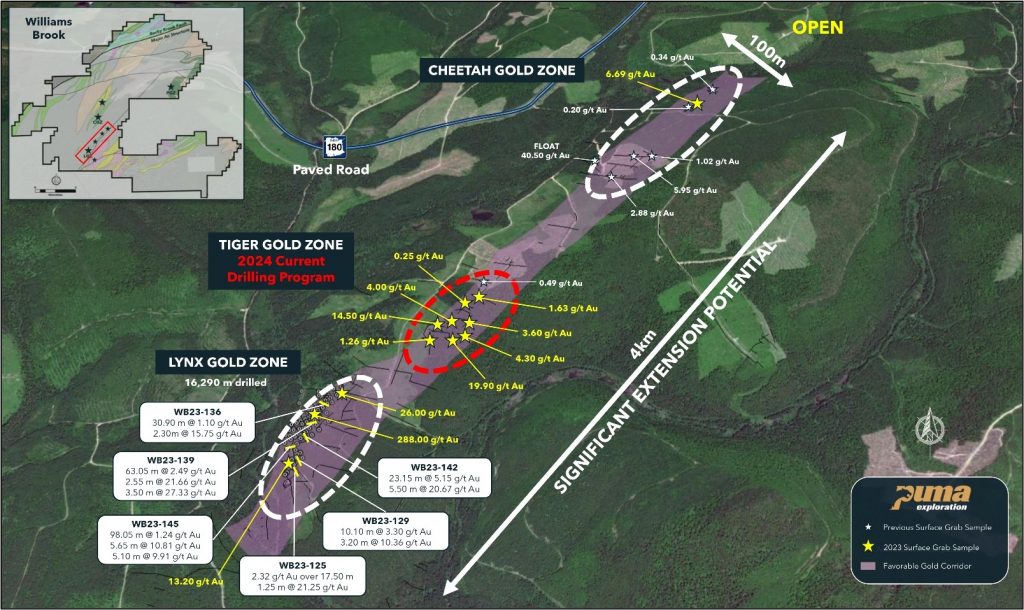
Puma Exploration (TSXV:PUMA) recently shared updates on its drilling activities at the Tiger Gold Zone (TGZ) within the Williams Brook Gold Project in Northern New Brunswick. The company owns 100% of this project and has initiated a 2,000 meters drilling program targeting the gold zone discovered last year. The aim is to explore the northeast extension of the gold mineralized corridor from the Lynx Gold Zone (LGZ) over a 1.5 km stretch and to potentially widen this zone. Initial observations from the drilling cores have been positive, leading to an expansion of the drilling program.
Marcel Robillard, President and CEO of Puma Exploration, commented in a press release: “We are thrilled with what we see in the first 800 metres drilled so far at Tiger. The core exhibits the same pervasive alteration and mineralization characteristic of the Lynx Gold Zone. This further supports our belief that we are dealing with a large gold system and that the Lynx Gold Zone extends at least 1.5 kilometres along strike. Following these observations, we have expanded our drilling program by adding scouting drill holes along another 2-kilometre extension. With our exploration program fully funded, our focus is to grow the scale and resource along the Lynx Gold Trend in 2024.”
The drilling at TGZ is designed in a shallow fan pattern to examine the mineralization beneath the surface gold veins, which were identified through trenching and mapping in the previous year. This effort seeks to understand the factors controlling gold mineralization in the area and how the TGZ integrates into the company’s existing structural and lithological models. It’s important to note, however, that grab samples, which are part of the exploration process, are selective and might not accurately reflect the overall metal content of the mineralized zones.
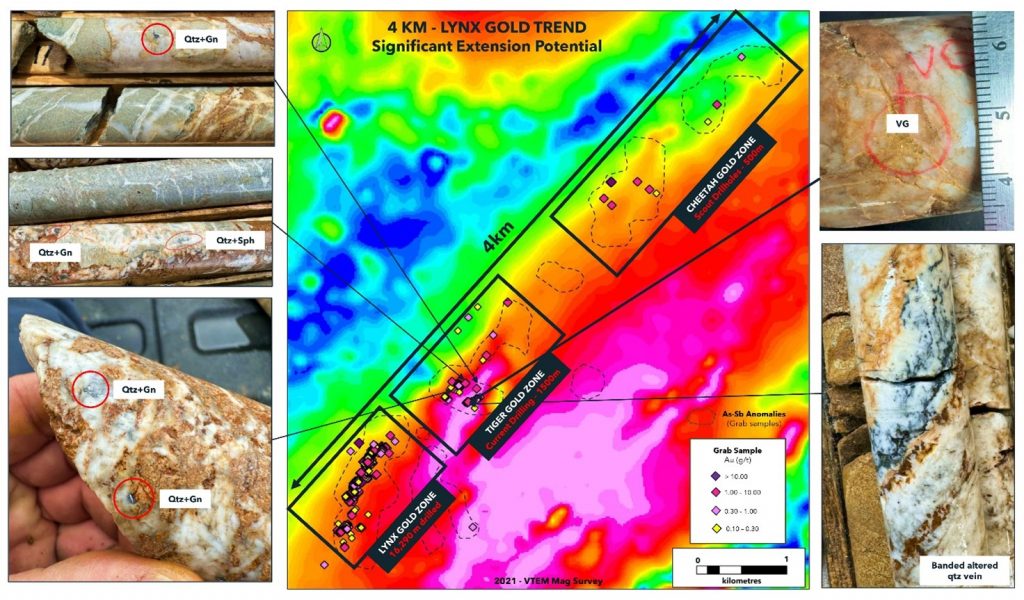
Previous geophysical and geochemical surveys have pointed out several target areas along the Lynx Gold Trend. Limited trenching conducted by earlier operators followed these surveys. Last year, Puma uncovered another promising gold area named the Cheetah Gold Zone (CHGZ), revealing 6.69 grams per tonne (g/t) gold from its initial trenching and sampling.
The TGZ, located 350 meters from the LGZ, was expanded through surface exploration work along the Lynx Gold Trend in 2023. This work confirmed gold mineralization over a stretch exceeding 1.5 km, with four significant mineralized quartz veins yielding high-grade gold results, including assays of 19.90 g/t and 14.50 g/t gold. These findings confirm the continuity of high-grade gold mineralization within the hydrothermal alteration corridor observable at the surface. The exploration program has also verified that the gold mineralized corridor extends to shallow depths at Tiger, remaining open along its strike and depth.
The area of the Tiger Gold Zone now covers 400 meters by 180 meters. Gold here is primarily found in quartz veins, which range from drusy to massive, and are accompanied by minor carbonate and sulphides like chalcopyrite, sphalerite, galena, and malachite. This mineralization pattern is similar to the high-grade veins previously discovered at the Lynx Gold Zone. Notably, these quartz veins are located at the juncture between different rock types, including volcanic and sedimentary units and a significant mafic unit, indicating a complex geological setting conducive to gold deposition.
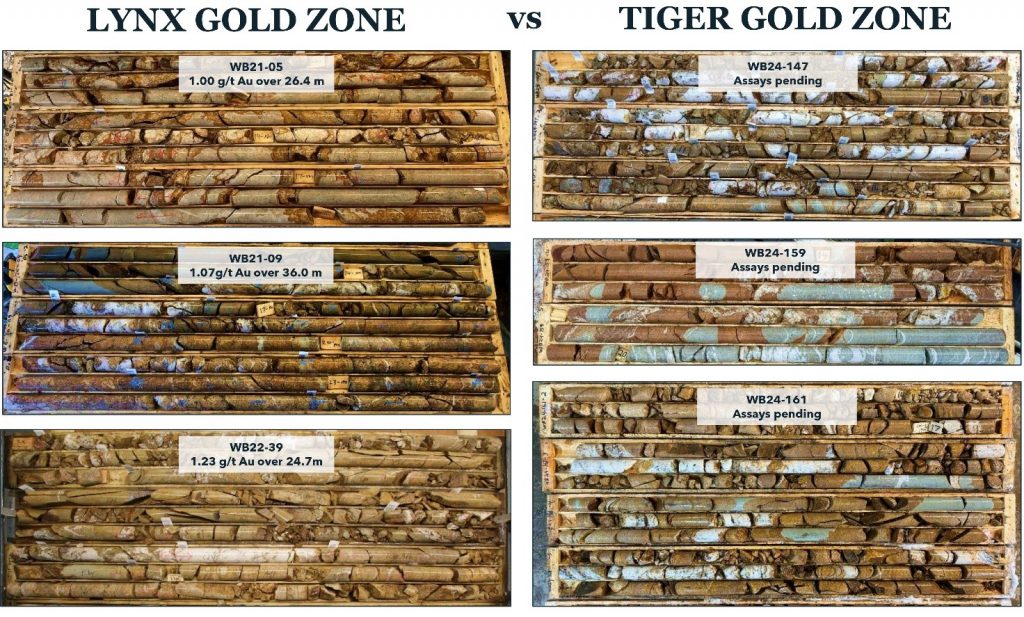
Highlights from the results are as follows:
- Fifteen (15) holes with depths from 25 to 150 m have been completed for a total of 875 metres.
- The holes were drilled 425 metres from the Lynx Gold Zone (Figure 1).
- All holes intersected the targeted favourable gold-bearing horizon of quartz veins / stockwork in altered sediment and gabbro units.
- Visible gold was observed in hole WB24-151 in a quartz vein in altered gabbro (Figure 2).
- The same pervasive alteration corridor characteristic of the LGZ is observed at Tiger (Figure 3).
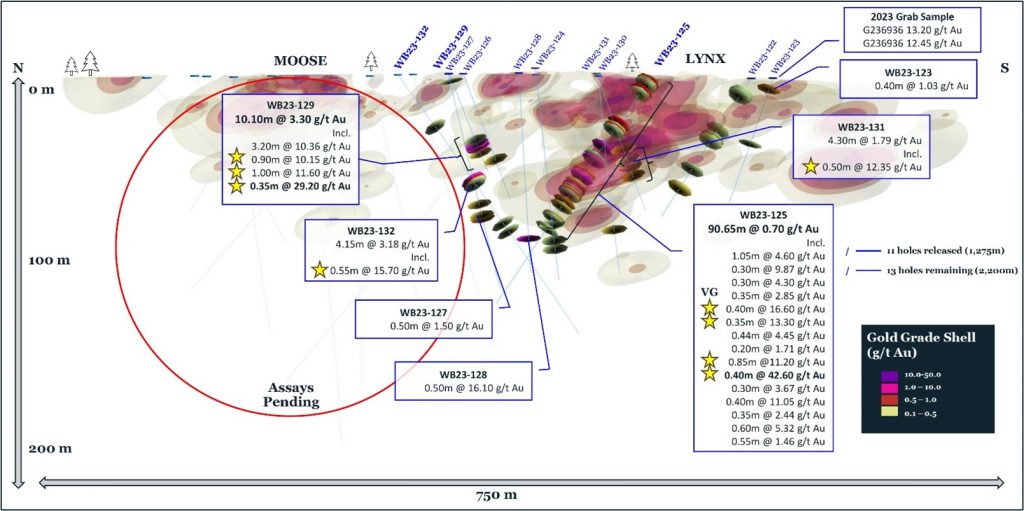
Puma Exploration (TSXV:PUMA) has reported findings from the first 11 holes of its 2023 drilling program at its Williams Brook Gold Project in Northern New Brunswick. The company reported that seven of these 11 holes returned significant amounts of gold, with four holes intersecting multiple high-grade gold quartz veins. Notably, Hole WB23-125 intersected 15 separate quartz veins and showed significant levels of gold, including an interval that measured 6.46 grams per ton (g/t) of gold at a depth of 75 meters.
Puma Exploration President and CEO Marcel Robillard commented in a press release: “The first holes of our Phase 1 2023 campaign were drilled to map and test the newly identified veins discovered at surface at Lynx earlier this year and the depth continuity of the interpreted high-grade shoots at Lynx. Many holes hit multiple quartz veins downhole, often starting at surface. Hole 125 was drilled to 170 m depth, and we saw VG in 4 veins from 55 to 79 m depth. Those returned grades of 11.20 to 42.60 g/t gold over 0.35 to 0.80 m width. What’s most impressive is we intersected 15 veins, and they all contributed gold, regardless of whether they contained VG. That’s significant because it highlights the continuity of mineralization at Lynx and the potential for a large mineable system that remains open along strike and depth. Assay results for the remaining holes drilled deeper that returned numerous VG specks should be in soon. We expect they will extend the width and depth of the gold chutes and continue to build volume at Lynx.”
The 11 holes were initially reported on August 2, 2023, and were not part of the drilling series that yielded over 100 visible specks of gold upon first inspection. Assay results from these 11 holes ranged from anomalous gold levels of 0.1 g/t to as high as 42.60 g/t. These results support the indication of considerable continuity and depth extension of gold mineralization in the Lynx Gold Zone.
The drilling also explored previously untested areas and found broad mineralized zones, indicating the existence of additional gold chutes. For instance, results included 0.5 meters of 16.1 g/t gold in WB23-128 and 19.35 meters of 0.54 g/t gold in WB23-131. Results for the remaining 13 holes in the 2023 drilling program are still pending and will be made public upon receipt.
The Phase 1 drilling effort was primarily concentrated on the Lynx and Moose areas and aimed to confirm and extend high-grade gold mineralization. The program expanded from 15 to 24 holes after successfully intercepting depth extensions of high-grade shoots previously defined by other drilling initiatives.
In a geological context, most of the drilled holes showed widespread sericitization. However, visible gold and potential bonanza-grade veins were found to be associated with carbonate alteration, specifically dolomite, as well as with sulphide assemblages of pyrite, chalcopyrite, galena, and sphalerite occurring either as disseminated massive sulphides or semi-massive veinlets within the quartz veins.
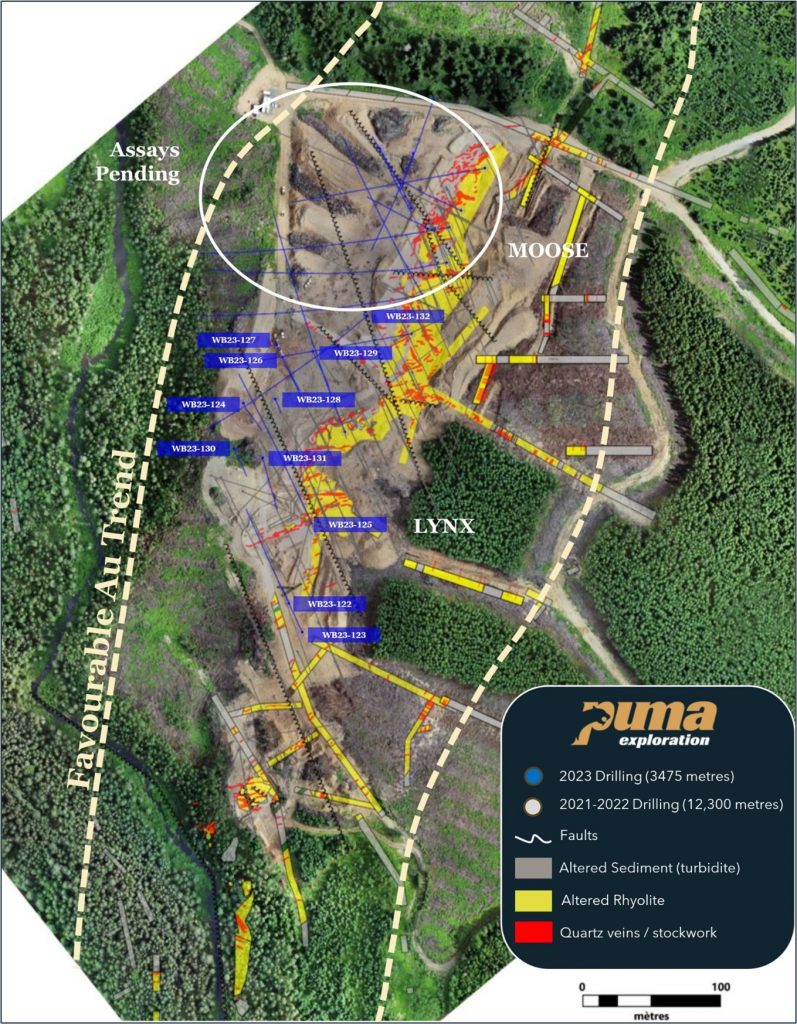
Highlights from the results are as follows:
- Hole WB23-125 returned 50.85 m of 1.05 g/t gold.
- Gold mineralization extends over 90 m from surface in a series of stacked high-grade quartz veins.
- All 11 holes intersected the targeted quartz veins, with assay results returning from anomalous gold (0.10 g/t) to 42.60 g/t.
- Gold was intercepted at depth in areas never drilled before.
- Results confirm the continuity of gold mineralization at the Lynx Gold Zone.
- Assay results for 13 additional holes (2,200 m), including 47 samples containing VG are still pending
Table 1. Assay results of 2023 drilling
| DDH # | From (m) | To (m) | Length (m) | Au (g/t) |
| WB23-123 | 7.60 | 8.00 | 0.40 | 1.03 |
| WB23-125 | 2.90 | 93.55 | 90.65 | 0.70 |
| Incl. | 42.05 | 92.90 | 50.85 | 1.05 |
| Incl. | 66.25 | 92.90 | 26.65 | 1.70 |
| Incl. | 75.40 | 92.90 | 17.50 | 2.32 |
| Incl. | 78.65 | 92.90 | 14.25 | 2.67 |
| and | 75.40 | 79.90 | 4.50 | 6.46 |
| Individual samples | ||||
| 2.90 | 3.95 | 1.05 | 4.60 | |
| 11.00 | 11.30 | 0.30 | 9.87 | |
| 37.30 | 37.60 | 0.30 | 4.30 | |
| 42.05 | 42.40 | 0.35 | 2.85 | |
| 55.50 | 55.90 | 0.40 | 16.60 | |
| 66.25 | 66.60 | 0.35 | 13.30 | |
| 75.40 | 75.80 | 0.40 | 4.45 | |
| 76.05 | 76.25 | 0.20 | 1.71 | |
| 78.65 | 79.50 | 0.85 | 11.20 | |
| 79.50 | 79.90 | 0.40 | 42.60 | |
| 87.15 | 87.45 | 0.30 | 3.67 | |
| 88.00 | 88.40 | 0.40 | 11.05 | |
| 90.45 | 90.80 | 0.35 | 2.44 | |
| 91.75 | 92.35 | 0.60 | 5.32 | |
| 92.35 | 92.90 | 0.55 | 1.46 | |
| WB23-127 | 85.90 | 86.40 | 0.50 | 1.50 |
| WB23-128 | 95.15 | 95.65 | 0.50 | 16.10 |
| WB23-129 | 42.90 | 53.00 | 10.10 | 3.30 |
| Incl. | 45.25 | 48.45 | 3.20 | 10.36 |
| Incl. | 48.07 | 48.42 | 0.35 | 29.20 |
| WB23-131 | 46.25 | 65.60 | 19.35 | 0.54 |
| Incl. | 47.00 | 48.05 | 1.05 | 1.06 |
| and | 53.80 | 59.75 | 5.95 | 1.39 |
| Incl. | 57.60 | 58.10 | 0.50 | 12.35 |
| WB23-132 | 85.50 | 89.65 | 4.15 | 3.18 |
| Incl. | 86.15 | 89.07 | 2.92 | 4.43 |
| Incl. | 86.15 | 86.70 | 0.55 | 15.70 |
| and | 87.64 | 88.56 | 0.92 | 4.04 |
*Interval widths reported; true widths of the system are not yet known.
Table 2. Coordinates of drill holes
| DDH # | Easting (m)* |
Northing (m)* |
Elevation (m) |
Azimuth (°) |
Dip (°) |
Length (m) |
| WB23-122 | 660246 | 5259235 | 386 | 335 | -45 | 107.0 |
| WB23-123 | 660256 | 5259214 | 386 | 335 | -65 | 83.0 |
| WB23-124 | 660213 | 5259379 | 392 | 155 | -80 | 122.0 |
| WB23-125 | 660263 | 5259293 | 386 | 330 | -45 | 170.0 |
| WB23-126 | 660242 | 5259412 | 389 | 155 | -65 | 80.0 |
| WB23-127 | 660237 | 5259421 | 389 | 155 | -75 | 134.0 |
| WB23-128 | 660236 | 5259382 | 389 | 155 | -85 | 116.0 |
| WB23-129 | 660263 | 5259417 | 389 | 155 | -65 | 65.0 |
| WB23-130 | 660207 | 5259347 | 388 | 155 | -80 | 113.2 |
| WB23-131 | 660227 | 5259340 | 389 | 165 | -65 | 89.0 |
| WB23-132 | 660303 | 5259443 | 388 | 230 | -45 | 196.0 |
The above references an opinion and is for information purposes only. It is not intended to be investment advice. Seek a licensed professional for investment advice. The author is not an insider or shareholder of any of the companies mentioned above.
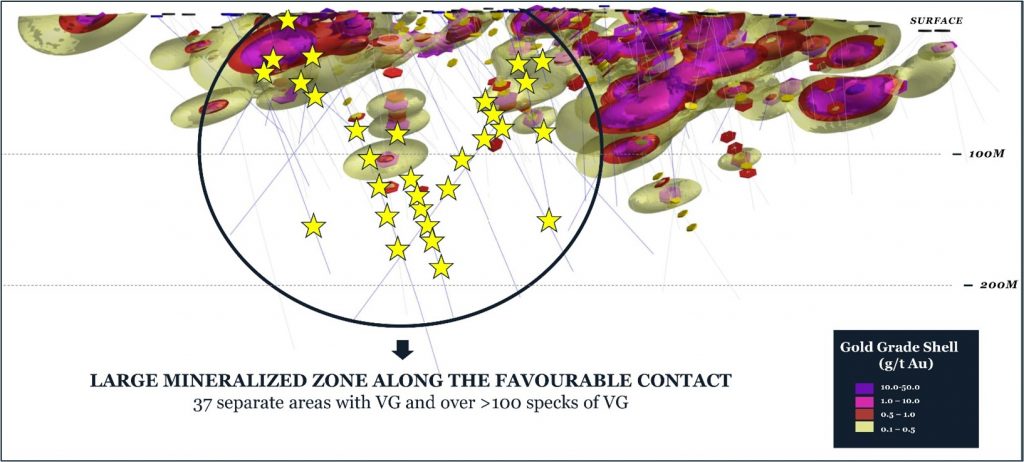
Puma Exploration (TSXV:PUMA) has reported preliminary findings from its 2023 drilling program at the Williams Brook Gold Project in Northern New Brunswick, Atlantic Canada, demonstrating that gold mineralization extends beyond 100 meters depth. The exploration, entirely owned by Puma, took place at the Lynx Gold Zone, where 24 holes amounting to 3,475 meters were drilled.
The drilling exposed more than 100 specks of visible gold in 37 different locations, with 16 occurrences situated between 100 meters and 211 meters downhole depth. The gold mineralization appears to be constrained at the favourable contact between rhyolite and sediment, and potential high-grade veins are often found in association with carbonate alteration (dolomite) and sulphides.
Puma Exploration President and CEO Marcel Robillard commented in a press release: “We are extremely pleased with this first phase of our 2023 drilling program and what we see in the core. There’s tremendous validation of our approach and model when we can hit VG successfully, and multiple instances of it is remarkable. The mineralization, mineralogy, alteration etc., all indicate that we are dealing with a large hydrothermal system that extends laterally and at depth. We are confident that we’ll substantially add to the gold inventory at the Lynx Gold Zone as we continue to advance our 2023 program and beyond.”
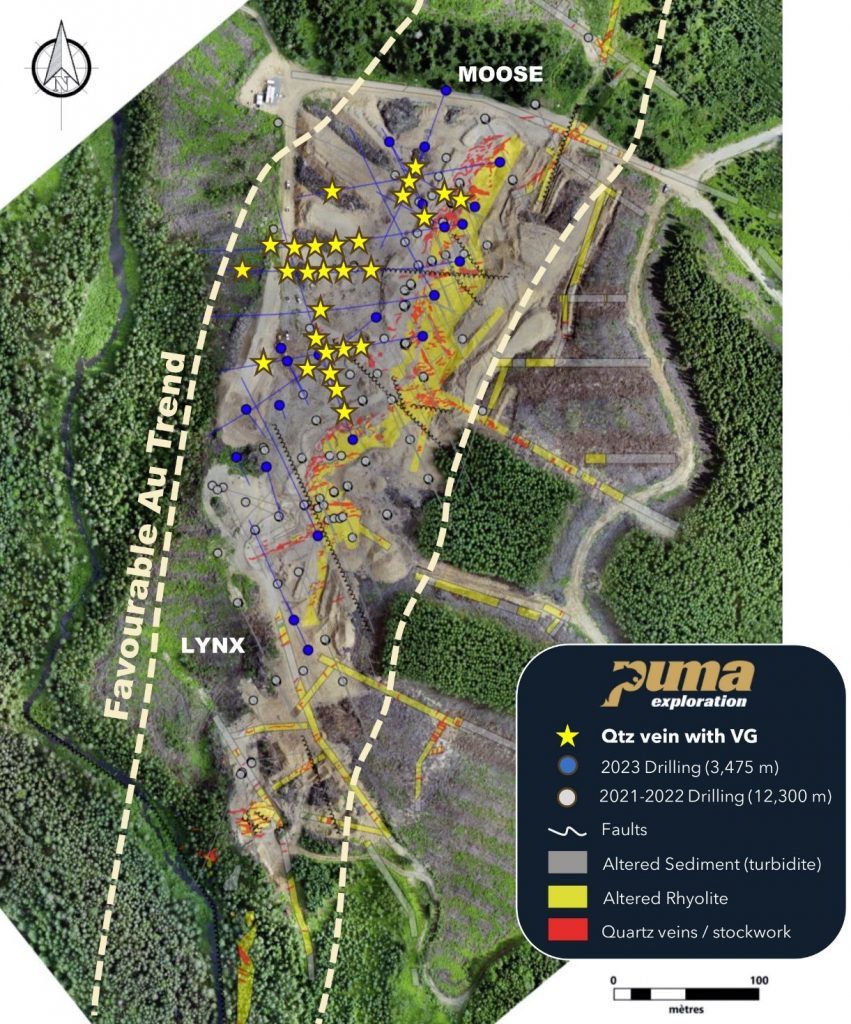
This initial phase of drilling was conducted with a specific focus on the Lynx and Moose areas of the LGZ and was purposed to confirm and expand the known high-grade gold mineralization both at depth and along strike. An additional objective was to target veins previously mapped at the surface using different drilling orientations to improve the understanding of the veins’ geometry and update the structural model.
The results from the Phase 1 drilling not only confirmed the extension of the mineralization beyond 150 meters depth but also shed light on the alteration observed in the core. As drilling reached 100 meters vertical depth, the supergene alteration transitioned to fresh sulphides. Although many holes showed pervasive sericitization, the presence of visible gold and associated potential high-grade veins was linked to the existence of carbonate alteration and specific sulphide assemblages. These sulphides were also found 255 meters downhole in one of the drilling holes.
Looking ahead at the 2023 Drilling Program, the fully-funded and permitted progress has three primary objectives: to extend the continuity of the LGZ at depth and along strike, to validate and refine the existing geological model, and to corroborate Puma’s current geophysical pathfinder tool. Initially planned for 15 holes and approximately 2,000 meters, Phase 1 drilling was expanded to 24 holes and 3,500 meters after the Company successfully intercepted the depth extensions of the high-grade shoots identified by previous programs. Assays from the Phase 1 drilling are still pending, and the results will be announced upon receipt.
To advance exploration, Puma is preparing to conduct surface exploration work to locate the favourable rhyolite sediment contact along the strike extension of the Lynx Gold Zone. This work is in preparation for the Company’s forthcoming Phase 2 drilling program. The discovery has marked a significant development in understanding the Williams Brook Gold Project’s potential and demonstrates Puma’s commitment to thorough exploration and evaluation.
Highlights from the results are as follows:
Table 1. Visible gold occurrences in Phase 1 2023 drilling
| DDH # | Downhole Depth (m) | Vein type | Host rock | Associated sulphides |
| WB23-129 | 45.4 | white qtz | rhyolite | ga |
| WB23-129 | 48.4 | white qtz | Sed-lim/GS in rhyolite | |
| WB23-132 | 87.9 | white qtz | sed-lim | ga |
| WB23-133 | 32.5 | fracture in GS | Sed altered-lim | |
| WB23-133 | 49.2 | white qtz | rhyolite | |
| WB23-133 | 50.3 | white qtz | Sed altered at contact with rhyolite | sph |
| WB23-133 | 60.7 | white qtz | Sed altered | |
| WB23-136 | 37.6 | milky white qtz brec with GS fragments | rhy-lim/Sed altered-lim | |
| WB23-137 | 3.0 | white qtz | sed-lim | |
| WB23-137 | 26.7 | white qtz brec. With rhy fragments | rhyolite-lim | |
| WB23-137 | 33.3 | stw QV 1cm | Rhy-lim | |
| WB23-137 | 33.6 | stw QV 1cm | Rhy-lim | |
| WB23-138 | 100.4 | white qtz | rhyolite | ga |
| WB23-138 | 109.2 | white qtz | rhyolite | ga-cpy-sph |
| WB23-138 | 138.7 | white qtz | rhyolite | ga-sph-lim |
| WB23-138 | 153.8 | white qtz | rhyolite | ga-sph-lim-ma-cpy |
| WB23-138 | 175.9 | white qtz | rhyolite | sph-ga |
| WB23-139 | 90.5 | white qtz | rhyolite | cpy-ga-sph |
| WB23-139 | 139.9 | white qtz | rhyolite | cpy-ga-sph |
| WB23-139 | 149.8 | white qtz | rhyolite | cpy-ga-sph |
| WB23-139 | 149.9 | white qtz | rhyolite | cpy-ga-sph |
| WB23-139 | 150.0 | white qtz | rhyolite | cpy-ga-sph |
| WB23-139 | 150.1 | white qtz | rhyolite | cpy-ga-sph |
| WB23-139 | 151.9 | white qtz | rhyolite | cpy-ga-sph |
| WB23-139 | 211.2 | white qtz | rhyolite | ga-sph |
| WB23-140 | 129.8 | white qtz | rhyolite | ga-cpy-py-sph |
| WB23-142 | 60.7 | Rusted qtz, stw | rhyolite-lim | |
| WB23-142 | 64.0 | white qtz | rhyolite-lim/sediment altered | ga-cpy-ma |
| WB23-142 | 82.0 | white qtz | rhyolite | ga |
| WB23-142 | 136.3 | white qtz, stw | rhyolite | ga-cpy-sph |
| WB23-144 | 161.7 | white qtz | rhyolite / sediment altered | ga-sph-cpy |
| WB23-145 | 80.6 | white qtz rusted | rhyolite-lim | ga-ma |
| WB23-145 | 81.8 | white qtz | rhyolite-lim | |
| WB23-145 | 81.8 | white qtz | rhyolite-lim | ga-cpy |
| WB23-145 | 82.6 | white qtz | rhyolite-lim | ga-cpy-sph |
| WB23-145 | 82.7 | white qtz | rhyolite-lim | ga-cpy-sph |
| WB23-145 | 174.4 | white qtz | rhyolite | ga |
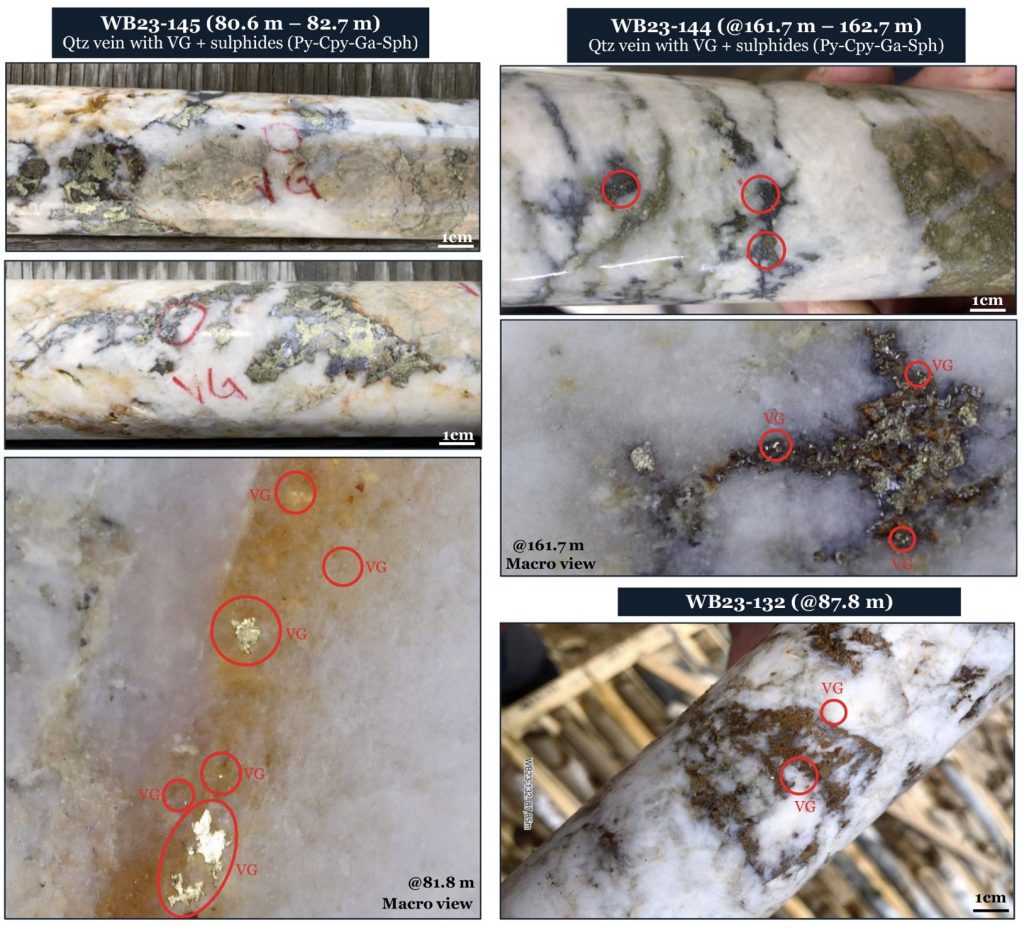
Table 2. Coordinates and depth of drilled holes
| DDH # | Easting * | Northing* | Azimuth (°) | Dip (°) | Length (m) |
| WB23-122 | 660246 | 5259235 | 335 | -45 | 107.0 |
| WB23-123 | 660256 | 5259214 | 335 | -65 | 83.0 |
| WB23-124 | 660213 | 5259379 | 155 | -80 | 122.0 |
| WB23-125 | 660263 | 5259293 | 330 | -45 | 170.0 |
| WB23-126 | 660242 | 5259412 | 155 | -65 | 80.0 |
| WB23-127 | 660237 | 5259421 | 155 | -75 | 134.0 |
| WB23-128 | 660236 | 5259382 | 155 | -85 | 116.0 |
| WB23-129 | 660263 | 5259417 | 155 | -65 | 65.0 |
| WB23-130 | 660207 | 5259347 | 155 | -80 | 113.2 |
| WB23-131 | 660227 | 5259340 | 165 | -65 | 89.0 |
| WB23-132 | 660303 | 5259443 | 230 | -45 | 196.0 |
| WB23-133 | 660336 | 5259560 | 202 | -45 | 107.3 |
| WB23-134 | 660312 | 5259564 | 155 | -65 | 122.0 |
| WB23-135 | 660335 | 5259521 | 335 | -55 | 100.0 |
| WB23-136 | 660350 | 5259505 | 295 | -55 | 92.0 |
| WB23-137 | 660371 | 5259519 | 295 | -50 | 87.0 |
| WB23-138 | 660362 | 5259507 | 260 | -45 | 257.0 |
| WB23-139 | 660361 | 5259481 | 260 | -45 | 230.0 |
| WB23-140 | 660343 | 5259458 | 260 | -45 | 218.0 |
| WB23-141 | 660343 | 5259458 | 330 | -45 | 178.0 |
| WB23-142 | 660287 | 5259359 | 338 | -46 | 236.0 |
| WB23-143 | 660351 | 5259599 | 202 | -45 | 101.0 |
| WB23-144 | 660388 | 5259550 | 260 | -46 | 197.0 |
| WB23-145 | 660335 | 5259430 | 260 | -46 | 275.0 |
| * Projection: UTM Nad83 zone 19 | Total: | 3475.5 | |||
The above references an opinion and is for information purposes only. It is not intended to be investment advice. Seek a licensed professional for investment advice. The author is not an insider or shareholder of any of the companies mentioned above.
If you would like to receive our free newsletter via email, simply enter your email address below & click subscribe.
CONNECT WITH US
Tweets
Tweet with hash tag #miningfeeds or @miningfeeds and your tweets will be displayed across this site.
MOST ACTIVE MINING STOCKS
Daily Gainers
 Ratel Group Ltd. Ratel Group Ltd. |
RTG.TO | +60.00% |
    |
ERL.AX | +50.00% |
    |
MRQ.AX | +50.00% |
        |
AFR.V | +33.33% |
    |
CRB.AX | +33.33% |
        |
GCX.V | +33.33% |
        |
RUG.V | +33.33% |
        |
CASA.V | +30.00% |
        |
BSK.V | +25.00% |
        |
PGC.V | +25.00% |
Articles
FOUND POSTS
Arras Minerals (TSXV:ARK) Updates on Elemes Drill Program in Kazakhstan
December 19, 2024
Potential Trump Tariffs Could Reshape Copper Market Dynamics in 2025
December 17, 2024

 Follow us on Twitter
Follow us on Twitter Become our facebook fan
Become our facebook fan







